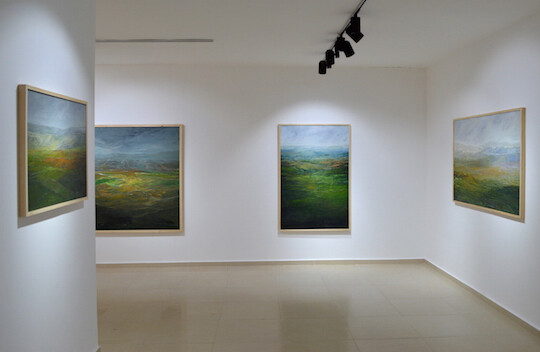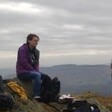Arts and Culture 22 April 2015

Rafat Asad’s Marj Ibn Amer exhibition at Zawyeh Gallery, Ramallah.
Marj Ibn Amer, a exhibition of new paintings by Nablus-born artist Rafat Asad, opens at Ramallah’s Zawyeh Gallery on 25 April, running until 14 May.
The show focuses on Asad’s painted work, although the artist also works in media including sound and light installations, video and performance. As well as a number of group exhibitions, Asad’s work has been profiled in solo shows in Nablus (1999), Ramallah (2006) and London (2006).
According to a statement by Asad on the paintings in the show, which all date from 2014 and 2015, Marj Ibn Amer is:
an extensive investigation into my own relation with the landscape of Palestine. Artworks are deliberately clear of any human traces or actions. Landscape is spontaneous. Nature is pure. This is an attempt to engage with my personal experiences since childhood, a chronicle that first started in my previous exhibition “Narrative,” and continues here, yet comprehensively.
As such, his paintings fall into the strong tradition within Palestinian art – visual and written – of celebrating the land and its beauty, and thus evoking an implicit melancholy because of the exile of so many of these artists from their subjects.
This sense is very much present in the Marj Ibn Amer exhibition, as this fertile plain, the site of many significant events in Palestinian history, is divided by the separation wall. Part of it lies within the West Bank, surrounding the city of Jenin, but much of it is inaccessible to Palestinians living under military occupation because it extends into the Galilee, in present-day Israel.
Writer and curator Nicola Gray, who has been involved in numerous Palestinian art shows and festivals, has also contributed a narration to the exhibition and catalog, which compares Rafat Asad’s paintings of the Marj Ibn Amer with Vincent Van Gogh’s absorption in the French landscapes depicted in some of his masterpieces.
Gray also highlights the fact that, despite Asad’s familiarity with the Marj Ibn Amer, having looked at its distant colors throughout his life, he is unable to reach much of it, “resulting in the creation of an unattainable landscape the artist can only experience as a vista to a far horizon.”
Gray goes on to point out that:
In the West Bank hills, there are other locations where the vistas across open space have led to them becoming iconic sites of significance. Looking west from certain places in Ramallah on a clear day, the glitter of the Mediterranean can be seen, only a short drive away but unattainable to most; the village of Al Ubeidiya, near Bethlehem, is now the only place where many Palestinians can see Jerusalem and the Dome of the Rock glinting in the sun. Looking across Marj Ibn Amer, we look to the north and the usurpation of its fertile agricultural land.
But she also draws out the fact that:
Rafat’s paintings are deceptive in their apparent celebration of light and air, the colors of the seasons, the patterns of the fields, the gentle slopes of the hills, the edgelands where town meets field; they hide more than they reveal. They are not painted en plein air as Van Gogh did, and if the separation wall is visible in any of these actual views, the artist has not included it. They are an amalgam of the artist’s imagination and memory with the art of painting and the illusionary but liberating space it can so brilliantly create.






Comments
Bravo
Permalink Jerry Frost replied on
Bravo --free Palestine
Ramallah exhibition celebrates “pure” Palestinian landscape
Permalink Agnes Btffn replied on
As I have seen Rafat Assad's paintings in Ramllah last year ,the size og those I saw is important to mention ! The paintings are large an like embrasse the landscape. I think of how most palestinians are living in narrow and crowded spaces, the refugee camps like Balata and many others !
Thanks Rafat for your paintings ! Agnes